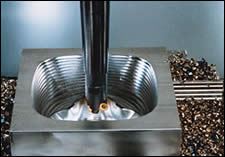Milling Adaptor: Reach Without Reluctance
An alternative to conventional extended-reach toolholders, milling adaptors contain a custom damping mechanism to minimize vibration when milling long overhangs.
Share





Hwacheon Machinery America, Inc.
Featured Content
View More


Machining deep pockets or cavities requires holding the tool at a large length-to-diameter (L/D) ratio or overhang. In the mold and die sector, shops may need to extend the tool as far out as 2 or 3 feet. The farther the tool extends from the spindle, the more sensitive the application becomes toward vibration.
Most shops respond with delicacy. Process parameters may be adjusted to compensate for the diminished stability. At long overhangs, shops reduce the speeds, feed rates and depths of cut. However, this causes productivity levels to dip. A more appealing option is to employ tooling that is able to calm the chatter.
Sandvik Coromant Co. (Fair Lawn, New Jersey) offers an alternative to conventional extended-reach toolholders: a “Silent Tools” milling adapter that features characteristics for minimizing vibration. According to the manufacturer, the custom damping mechanism encased in the adapter body can quiet virtually any perceptible chatter while end milling or profile milling with overhangs as long as seven times the diameter. Jim Grimes, a technical specialist at Sandvik Coromant, explains that reducing vibration doesn’t have to translate to slower speeds and feeds or lighter depths of cut.
The adapter connects to a machining center toolholder via a Sandvik Coromant Capto coupling. A single toolholder can therefore use different lengths of adapters.
Within the adapter, the tuning body (see illustration) effectively absorbs the chatter that is triggered during milling. This mass is suspended inside the bar with two rubber bushings—one at each end. Oil surrounds the tuning body. If harmonic oscillation tendencies arise during machining, the tuning system springs into action (so to speak). The kinetic energy of the vibration is counteracted by the movement of the tuning body against the rubber bushings in the oil. In this way, the vibration is damped and quieted.
“Any radial movement of the tool can generate vibration,” says Mr. Grimes. “To counteract this, the body inside the shank moves in the opposite direction of the cutting edge because of the way it is suspended in the fluid.”
Proven in mold and die applications, the damped milling adapters have also been implemented by companies in the aerospace sector to avoid problems associated with chatter. In applications such as these, Mr. Grimes says the ROI comes from productivity because shops can successfully mill at challenging overhangs to achieve faster material removal rates.
Related Content
-
The Impact of Cutting Teeth Spacing on Machining Stability
Many cutter designs are available, and variable teeth spacing (or variable pitch) cutters can be used to influence milling stability. Let’s discuss why teeth spacing affects stability.
-
Tungaloy Drills, Milling Inserts Provide Enhanced Stability
Tungaloy has expanded its DrillForceMeister and TecMill lines with new drill bodies and milling inserts.
-
GWS Tool Group End Mill Provides Dynamic Milling
Eastec 2023: The Hurrimill AT4 all-terrain end mill features radial-end gashing, which enables drilling, steep ramping and aggressive helical entry.








































